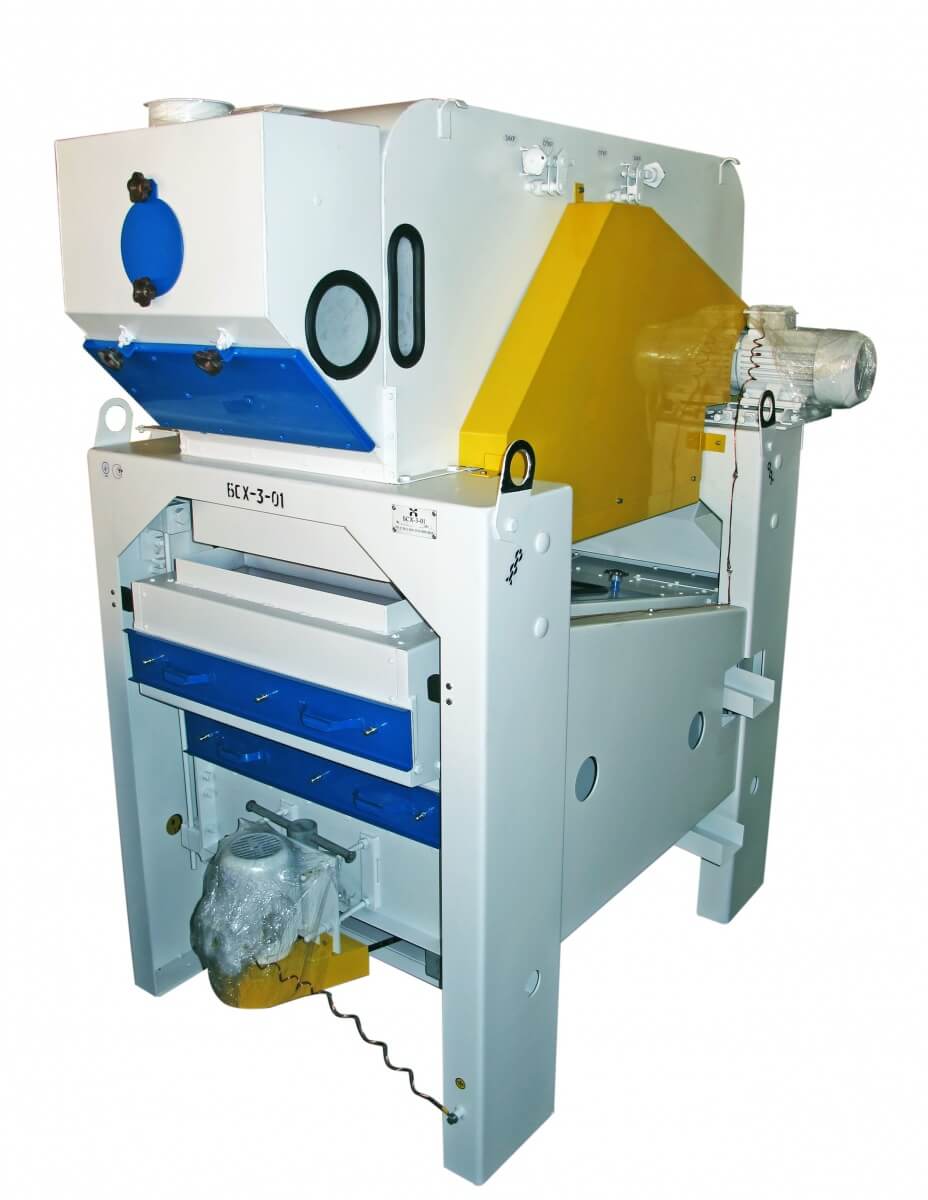Purpose:
Grain cleaning separator БСХ-3-01 is designed for cleaning grain (wheat, rye, oats, etc.) from impurities differing from it by geometric dimensions and aerodynamic properties. The separator is designed for use as grain cleaning machines at agricultural enterprises, including explosive production facilities.
The machine made according to 3rd category of State Standard (No 15150, climatic execution “У”) for domestic market and export to temperate countries. Drum Sieve should operate in working terms at the temperature from -10 °С to + 40 °С. Relative humidity should be 80% if average annual temperature is + 15 °С and atmosphere pressure is 650 - 800 mmHg (86,6 – 106,7 kPa).
This machine is designed to be used at agriculture enterprises including explosive manufactures.
Specifications:
| Name of indicators |
БСХ-3-01 |
| 1.* Technical productivity, t/h: |
|
| - pre-cleaning (elevator mode) |
12 |
| - final cleaning (mill mode) for wheat with a moisture content of up to 15% and waste impurity content of up to 3% |
3 |
| 2. Efficiency of cleaning from the impurities, %, min.: |
|
| - pre-cleaning |
20 |
| - final cleaning for wheat with a moisture content of up to 15% and waste impurity content of up to 3% |
80 |
| 3. Installed capacity, kW, max. |
2,95 |
| 4. Airflow consumption, m3/h, max.: |
2 600 |
| 5. Vibration frequency of sieve body (VPM) |
325 |
| 6. Radius of body vibrations, mm, max. |
9 ± 2 |
| 7. Dimensions of separator without cyclone, mm, max.: |
|
| - length |
1 839 |
| - width |
1 284 |
| - height |
1 898 |
| 8. Weight, kg, max. |
810 |
| 9. Validity period, years |
8 |
Note.* Technical productivity in pos.1 concerns raw grain cleaning. It means the wheat with a bulk weight of 760 kg / m3 and a content of impurities (seeds of weeds and cultivated plants):
- Pre-cleaning up to 15% and with a moisture content of up to 20%;
- Final cleaning for wheat with a moisture content of up to 15% and an waste impurity content of up to 3%.
Design and operation:
These separators consist of the following units: machine bed, body with sieve frames, crossheads with balancing mechanism, sedimentary chamber, fan, fan drive, pneumatic channel, augers, feeder, outlet trays, fence. The body is suspended from the machine bed by flexible suspensions.
Sieve frames with sieves embedded the body along the slides. Slides are installed on the body sidewalls and fixed by pressing devices stationary.Sieve frames are divided into cells by longitudinal and transverse partitions. There are rubber balls in the cells to clean sieves from jammed impurities. There is electric engine on the front wall of sieve body. This engine drives the traverse pulley with an unbalanced weight attached to it. A sedimentary chamber with built-in fan and two augers is installed on top of the machine bed. The chamber has two channels. The first channel is to pre-blowing. The second chamber is to secondary blowing.
The feeder with valve is installed to the front wall of the sedimentary chamber. The valve let control constant level of incoming grain. Pneumatic separation channel is mounted ton the machine bed and sedimentary chamber. This channel cleans grain from the impurities, different from it in aerodynamic properties. Air flow adjustment is carried out by the upper valve using the handle. A bottom valve is provided for uniform product supply to the pneumatic channel.
The product to be cleaned through the feeder enters the first channel of the sedimentation chamber. This is pre-blowing. The grain is directed from the primary blowdown duct to the body section. The separator body makes circular movements, under the influence of which the product moves along the sieve and is sorted. Large impurities are removed from the separator through the tray, and the mixture of grain with small impurities, after passing through the sorting sieve, enters the lower frame of the sieves. Small impurities, get out through the undersowing sieve, fall on the bottom of the separator, and then are removed from the machine through a tray.
Cleaned grain moves into the pneumatic separation channel. Light impurities go away by intensive airflow. This is secondary blowing. Then the impurities stay in the second channel of the sedimentary chamber. Afterwards, these impurities go out of the separators by second auger. Final cleaned grain go out through lower receiver.









